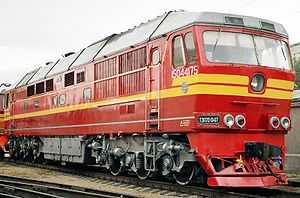TEP70
| TEP70 | |
|---|---|
 | |
| Specifications | |
| Power type | Diesel-electric |
| UIC classification | Co-Co |
| Gauge | 1,520 mm (4 ft 11 27⁄32 in) |
| Locomotive weight | 135 t (297,624 lb) |
| Top speed | 160 km/h (99 mph) |
| Power output | 2,964 kW (3,975 hp) |
| Career | |
| First run | 1973 |
The TEP70 main line single unit diesel passenger locomotive, rated at 2,964 kW (3,975 hp), with AC/DC transmission and individual axle traction control, is a railway engine designed to haul passenger trains on the Russian gauge railway network of eastern Europe. The TEP70 is currently in service in Russia, Ukraine, Belarus, Estonia, Latvia, Lithuania, and Kazakhstan.
The TEP70 diesel locomotive has been used as the basis of two other sub classes, the TEP70BS and the TEP70U.[1]
The TEP70 also shares a number of components with the 2TE70 two-unit freight locomotive.
Operators
- RZD (Russian Railways)
- Belorussian Railways
- Ukrzaliznytsia (Ukrainian Railways)
- Lietuvos Geležinkeliai (Lithuanian Railways)
- Latvijas dzelzceļš (Latvian Railways)
- GO Rail (Estonian operator)
- Qazaqstan Temir Zholy (Kazakhstan Railways)
Gallery
-
.jpg)
TEP70-0007 at the Central Museum of Railway Transport, Russian Federation, at Varshavsky Rail Terminal, St.Petersburg
-
.jpg)
TEP70-0007 at the Central Museum of Railway Transport, Russian Federation, at Varshavsky Rail Terminal, St.Petersburg
-
.jpg)
TEP70-0007 at the Central Museum of Railway Transport, Russian Federation, at Varshavsky Rail Terminal, St.Petersburg
-
.jpg)
TEP70-0007 at the Central Museum of Railway Transport, Russian Federation, at Varshavsky Rail Terminal, St.Petersburg
-
.jpg)
TEP70-0007 at the Central Museum of Railway Transport, Russian Federation, at Varshavsky Rail Terminal, St.Petersburg
-
.jpg)
TEP70-0007 at the Central Museum of Railway Transport, Russian Federation, at Varshavsky Rail Terminal, St.Petersburg
-
.jpg)
TEP70-0007 at the Central Museum of Railway Transport, Russian Federation, at Varshavsky Rail Terminal, St.Petersburg
See also
- The Museum of the Moscow Railway, at Paveletsky Rail Terminal, Moscow
- Rizhsky Rail Terminal, Moscow, Home of the Moscow Railway Museum
- Varshavsky Rail Terminal, St.Petersburg, Home of the Central Museum of Railway Transport, Russian Federation
- History of rail transport in Russia
References
| Wikimedia Commons has media related to Type TEP70 diesel locomotives. |
- ↑ "TEP70 Passenger Diesel Locomotive". Retrieved 2011-08-14.
| ||||||||||||||||||||||||||||||||||||||||||||||||||||